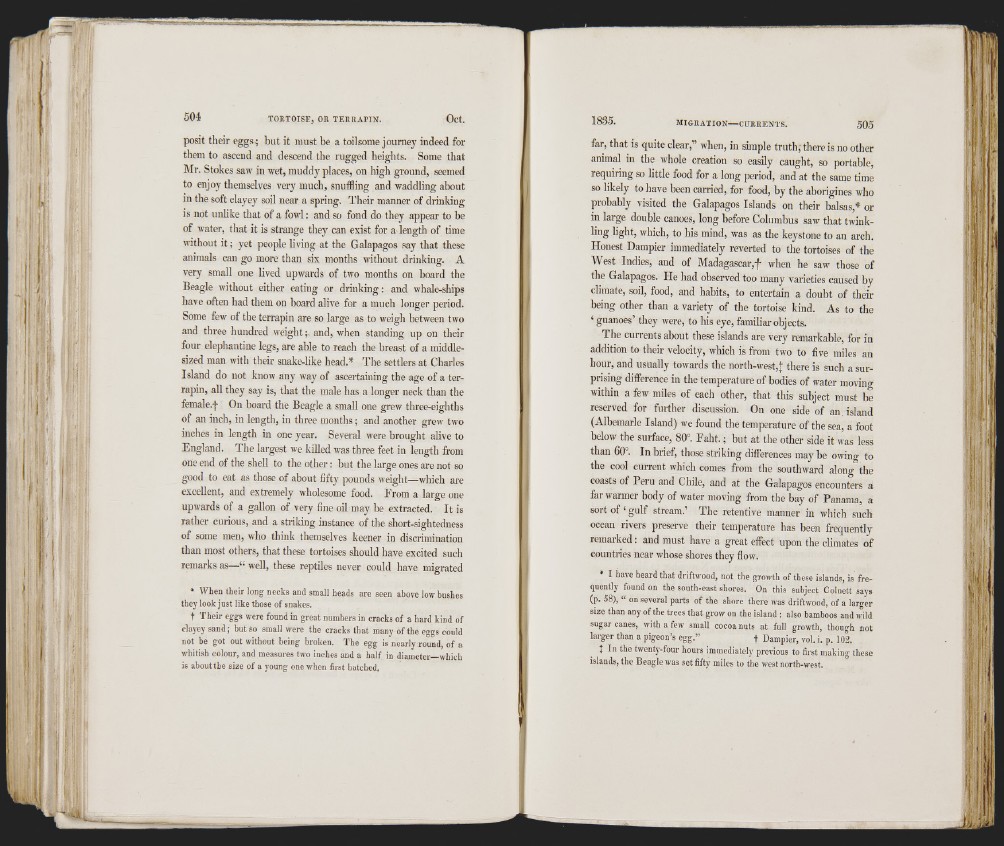
i I
, 1 '' ! -M
i: ifj
y M
í,
Mît' 1
: f
ilii.
J '
'I T
.í ‘
504 TORTOISE, OR TERRAPIN. Oct.
posit their eggs; but it must be a toilsome journey indeed for
them to ascend and descend the rugged heights. Some that
Mr. Stokes saw in wet, muddy places, on high ground, seemed
to enjoy themselves very much, snuffling and waddJing about
in the soft clayey soil near a spring. Their manner of drinking
is not unlike that of a fowl; and so fond do they appear to he
of watei-, that it is strange they can exist for a length of time
without it; yet people living at the Galapagos say that these
animals can go more than six months without drinking. A
very small one lived upwards of two months on board the
Beagle without either eating or drinking: and whale-ships
have often had them on board alive for a much longer period.
Some few of the terrapin are so large as to weigh between two
and three hundred we ig h tan d , when standing up on their
four elephantine legs, are able to reach the breast of a middle-
sized man with their snake-like head.* The settlers at Charles
Island do not know any way of ascertaining the age of a ter-
rapm, all they say is, that the male has a longer neck than the
female.f On board the Beagle a small one grew three-eighths
of an inch, in length, in three months; and another grew two
inches in length in one year. Several were brought alive to
England. The largest we killed was three feet in length from
one end of the shell to the other : but the large ones are not so
good to eat as those of about fifty pounds weight—which are
excellent, and extremely wholesome food. From a larg e one
upwards of a gallon of very fine oil may be extracted. I t is
rather curious, and a striking instance of the short-sightedness
of some men, who think themselves keener in discrimination
than most others, that these tortoises should have excited such
remarks as—“ well, these reptiles never could have migrated
* When their long; necks and small heads are seen above low bushes
they look just like those of snakes.
t Their eggs were found in great numbers in cracks of a hard kind of
clayey sand; but so small were the cracks that many of the eggs could
not he got out without being broken. The egg is nearly round, of a
whitish colour, and measures two inches and a half in diameter—which
is ahout the size of a young one when first hatched.
far, that is quite clear,” when, in simple truth; there is no other
animal in the whole creation so easily caught, so portable,
requiring so little food for a long period, and at the same time
so likely to have been carried, for food, by the aborigines who
probably visited the Galapagos Islands on their balsas,* or
in large double canoes, long before Columbus saw that twinkling
light, which, to his mind, was as the keystone to an arch.
Honest Dampier immediately reverted to the tortoises of the
West Indies, and of Madagascar,# when he saw those of
the Galapagos. He had observed too many varieties caused by
climate, soil, food, and habits, to entertain a doubt of their
being other than a variety of the tortoise kind. As to the
‘ guanoes’ they were, to his eye, familiar objects.
The currents about these islands are very remarkable, for in
addition to their velocity, which is from two to five miles an
hour, and usually towards the nortli-west,j there is such a sur-
pn'sing difference in the temperature of bodies of water moving
within a few miles of each other, that this subject must be
reserved for further discussion. On one side of an island
(Albemarle Island) we found the temperature of tbe sea, a foot
below the surface, 80°. Faht. ; but at the other side it was less
than 60°. In brief, those striking differences may be owing to
the cool current which comes from the southward along the
coasts of Peru and Chile, and at the Galapagos encounters a
far warmer body of water moving from the bay of Panama, a
sort of ‘ gulf stream.’ The retentive manner in which such
ocean rivers preserve their temperature has been frequently
remarked : and must have a gi-eat effect upon the climates of
countries near whose shores they flow.
* I have heard that driftwood, not the growth of these islands, is frequently
found on the south-east shores. On this subject Colnett says
(p. 58), “ on several parts of the shore there was driftwood, of a larger
size than any of the trees that grow on the island : also bamboos and wild
sugar canes, with a few small cocoa nuts at full growth, though not
larger than a pigeon’s egg.” + Dampier, vol. i. p. 102.
Î In the twenty-four hours immediately previous to first making these
islands, the Beagle was set fifty miles to the west north-west.
'MY
i'i!